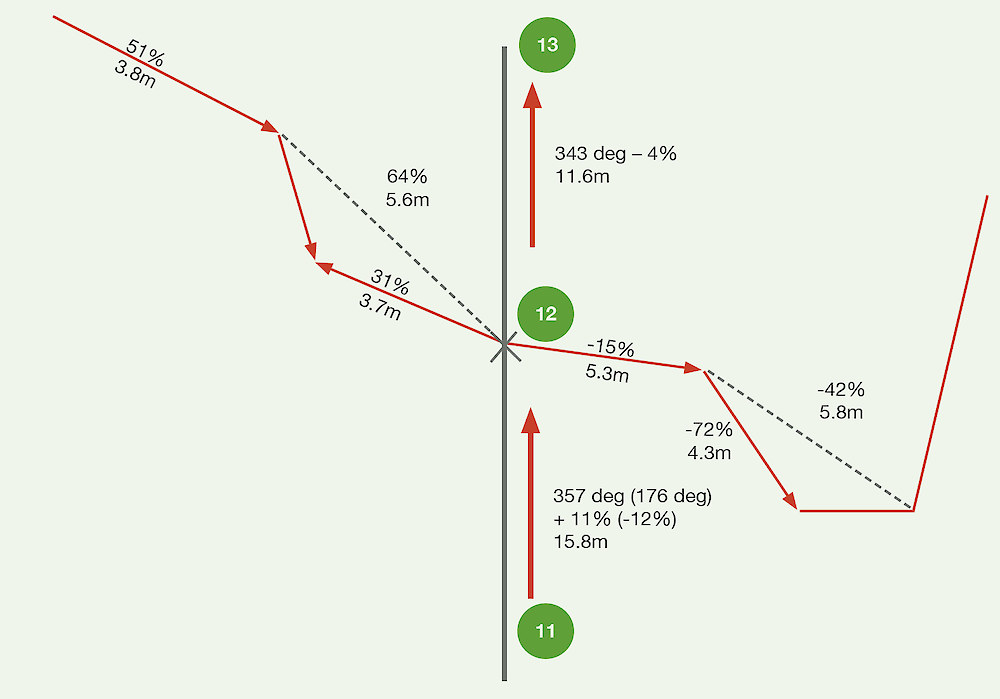A full road design requires detailed road survey data to allow for accurate feasibility assessment, including vertical and horizontal road location, and calculating earthwork volumes. A detailed road survey is effectively accurate terrain information of the grade line (P-Line) corridor. Because of the high level of detail required, contour map information derived from aerial photography is not adequate. The best source of information is LiDAR-derived digital terrain models (at the 1 m level), however a more traditional survey also yields very good results. While traditional survey data also lends itself to manual planning processes using paper plans, software is now commonly available to support the design process. As such, the survey data needs to be captured in a form that can readily be used by the software.
The traditional survey method requires equipment that is readily available:
- Fibreglass tape
- Clinometer
- Compass
- Field book
- Flagging tape and waterproof marker pen
- Stakes (optional).
Modern surveying equipment may prove to be a more effective method. For example, a laser rangefinder that incorporates a compass replaces the need for a measuring tape, clinometer and a compass. It is possible for a laser rangefinder to be linked to a data-logger for direct capture of survey data, which eliminates a notebook.
The survey moves along the grade line or P-Line that approximates the road centreline, that has been established in the forest. This ensures that the road survey traverse is reasonably close to the final road location, thereby reduce errors and problems when designing the roadline.
The survey involves measuring cross sections at regular intervals, so that a three-dimensional model of the terrain along the proposed road corridor is established. From this, the design plan line, longitudinal section and cross-sections can be produced. There are many variations in road surveying methods and in the setting out of a field book; these mostly depend on personal preference or established formats.
One method of a standard forest road survey, that is consistent with the input required for RoadEng, is outlined below:
- Establish stations at 20 m intervals or less, or where the terrain allows, near the proposed road centreline or grade line (the road centreline may be adjusted left or right after geometric design has optimised the location). Stations should also be located at gradient changes in the existing topography, that is, at the base of slopes, on ridges and in hollows. Marking stakes are often used to mark the survey station points, or the nearest available tree is marked as a station. These stations are labelled 1, 2, 3 … or the distance from the start, for future reference. These station locations are used for final design roadline set-out
- Record compass bearing, gradient (%) and slope distance from station to station. If a laser rangefinder is used, the horizontal and vertical distance between stations can be read directly. Note that errors accumulate so carefully take and record data
- Record cross sections, by measuring slope and distance to sample points on a line perpendicular to the survey traverse line
- Measure slope in %; downhill slopes are recorded in negative values
- Measure the slope and distance of side-shots, also called called cross sections, from point to point, or from a change point to point. Point to point is where the surveying leap-frogs to the next point to take a measurement, while change point to point is where the surveyor stands in one position to take several side-shots. The choice depends on the easiest method in the field, and on the road design software used. Change point is likely to be more accurate as error isn’t accumulated. The number of side-shots taken needs to adequately represent the ground surface.
Field book set-out in RoadEng format
Recording slope, bearing and slope distance between survey stations Source: Walbridge,1997
Source: Walbridge,1997
Measuring the slope and slope distance for left and right cross sections Source: Walbridge,1997
Source: Walbridge,1997
It is important to realise that the survey stations are not necessarily the same as the grade line marks. The survey stations represent changes in topography, and it is common to put stakes into the ground to represent survey stations, rather than to use marking tape on trees. The stakes can be easily distinguished and placed where needed rather than having to use a nearby tree.
Reference points are useful on the survey line. These are points that are outside of the roadline salvage width so known points can be re-established after felling.
A survey field book should be used to facilitate accurately recording the information and speeding up the process. An example of a field book can be seen above. However, a common mistake is to miss out the negative sign for a downhill slope, which could go unnoticed without a sketch of the cross-section. Tabular methods are recommended only for experienced survey crews.